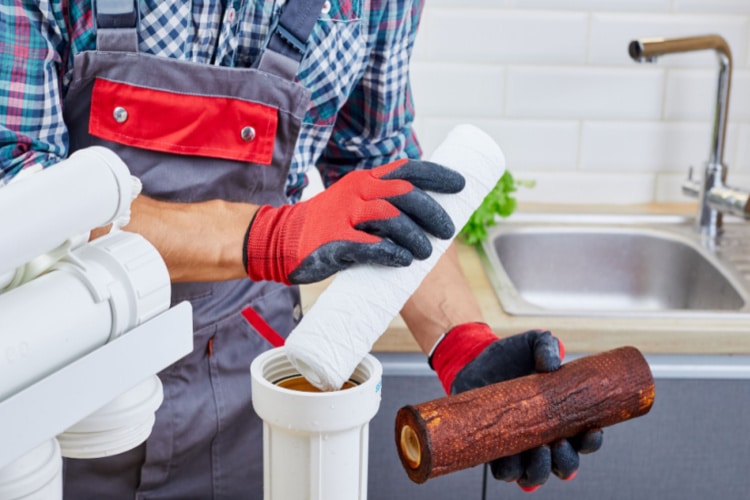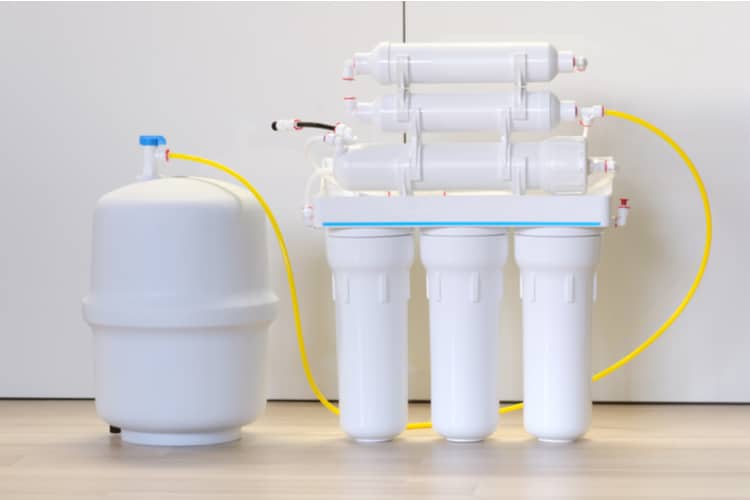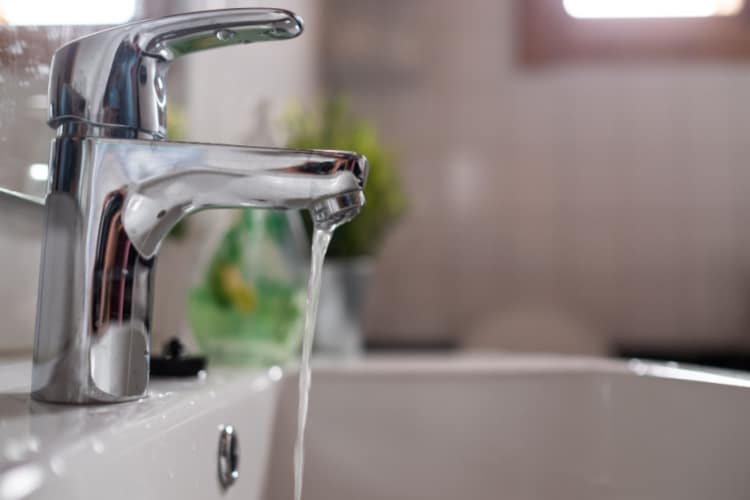Your RO system might experience low water pressure for multiple reasons ranging from clogged filters and membrane to air pressure in the tank.
Some of the most frequent causes, however, are low pressure inside a full tank, a faulty water supply line valve, and low water pressure from the city water line. Sometimes, the issue can even be a ruptured bladder tank.
Here’s a breakdown of the most common reasons for low water pressure in a reverse osmosis system:
- Clogged filters or Membrane
- Ruptured bladder tank
- Problem in water supply lines
- Low air pressure inside tank
- Fluctuating water pressure
1. Clogged RO Filters Or Membrane Can Cause Low Water Pressure
If you have a slow water flow rate in your RO system, the most likely issue will be the filters or the membrane. Over time, they tend to get clogged up.
This is due to the fact that reverse osmosis filters continuously separate harmful contaminants, microscopic dirt particles, and other impurities from the water supply. When all this builds up, it can restrict the regular water flow.
You can avoid this problem by changing your filters at least once a year. If the water in your area is particularly impure, it’s a good idea to change your RO filters every six months.

The same goes for your reverse osmosis membrane. This membrane should be replaced every three years. The time frame yet again largely depends on the water condition but also the model of your RO system.
When the membrane gets clogged, your RO system will take a lot longer to produce clean drinking water.
If you have difficulty replacing this part on your own, you can also reach out to your local technician to guide you through the process.
2. Ruptured Bladder Tank Can Cause Slow Water Flow
There are multiple reasons that can cause the holding tank bladder of an RO system to rupture. However, in most cases, it’s due to a lack of regular maintenance.

Detecting a ruptured tank is pretty straightforward. Simply check if the water flow rate decreases after providing one cup or 8 oz of water.
If you establish that your RO tank is ruptured, you will need to consult with an expert and replace the entire storage tank with a new one.
3. Problem in Water Supply Lines
If you have a twisted or crimped water line somewhere in your RO system, the water flow will become slower.

To determine whether this is the reason for your low water pressure, check the water supply lines in your RO system and see if the hoses are properly connected. If you come across a twisted hose, simply straighten it by hand.
While you’re at it, you should also inspect the water supply valve and make sure it’s open all the way.
4. Air Pressure Inside the RO tank Is Low
Inside your RO system, there’s a pressurized tank that needs to maintain a certain amount of air pressure in order to provide optimal water flow. If this pressure drops, you’ll have a slower water flow.

The pressure inside a 24-gallon tank should be 6 to 8 PSI (pounds per square inch) when empty. Thankfully, checking the air pressure inside the tank is quite straightforward. Check the Schrader valve that is placed under a blue color cap on the side of the water tank. This means checking that it’s connected properly and that it’s tight enough.
After doing this, you should also check the pressure with a pressure gauge. To do this, simply empty the water from the tank and measure the pressure with the gauge.
If the air pressure is lower than what it’s supposed to be, use an air pump and keep pumping air inside the tank. Take extra care when doing this, as extra pressure (> 8 psi) might damage the RO tank.
5. Fluctuating Water Pressure
A reverse osmosis system requires around 30-40 PSI of normal water pressure in order to operate, and 60 PSI to maintain optimal water flow.

Occasionally, the water pressure in your system might fluctuate temporarily due to inconveniences such as maintenance work or local water supply issues. The best course of action is to wait it out and see if the pressure goes back to normal after a day or two.
However, if the low water pressure issue persists, you should contact your local utility company and ask for guidance.
The Importance of Pressure in RO Systems
RO tanks contain two different compartments for air and water. Both compartments have to maintain a standard pressure to function properly.
The air that is pressurized inside the air compartment pushes water through the faucet. In order for this operation to be executed, the storage tank pressure has to be between 6 to 8 PSI when it’s empty.
Once water fills up, the tank pressure increases. The increased pressure is released when water flows through the faucet. For a tank full of water, the tank pressure should be at 30 PSI.
Most RO units feature a shut-off valve that stops the water production if the pressure in the tank exceeds the water pressure value. For optimal water pressure, your system’s pressure should be between 25 PSI and 70 PSI.
How to Increase or Maintain Pressure in an RO System
To increase the water pressure in your RO system, clean the filters regularly and replace the membrane annually. All of this falls under general maintenance and might seem like a no-brainer, but many tend to overlook it.
If the problem persists, look for a ruptured tank bladder, monitor the incoming water line, and maintain the optimal water and air pressure inside the storage tank.
If all else fails, you might have to install a sediment filter, add a flush kit, or get a new secondary water tank.
1. Regular Maintenance
Regular maintenance can prevent most of the common issues with your reverse osmosis system, including low water pressure.
By changing your RO filters and membrane in a timely manner and inspecting them on a weekly basis, you’ll prevent the build-up of dirt and contaminants. Additionally, it’s also a good idea to examine the storage tank, drain tube, feed water valve, and drain line regularly.
Make use of a PSI gauge or the valve under the blue cap of your system to keep the water and air pressure in check.
Consult an expert if you detect any leaks that disrupt the water flow.
2. Use an Electric Booster Pump
One of the easiest ways to improve the pressure and performance of your reverse osmosis system is by adding a booster pump.
This will increase the treated water production rate, boost the storage volume of the pressure tank, and improve the water flow rate that flows through the faucet.
However, do note that the feed pressure might increase up to 100 PSI with a booster pump, which is neither good nor bad (depends on you). There’s a screw on the pump to adjust the pressure to keep it at the desired levels at all times.
3. Install a Sediment Filter
If your RO filters get clogged frequently, whole-house sediment filters are a great option to consider.
Sediment filters are made of strong metal, which makes them very durable. They can increase your RO water pressure by:
- Improving the longevity of the filters;
- Bring clogging down to a minimum;
- Reducing the wear and tear on the system;
- Increasing the efficiency of the water filters.
4. Get a Secondary Water Tank
Installing a secondary water tank will improve the flow rate of the faucets. It basically doubles the capacity for pressure delivery.
Secondary tanks are available in compact sizes and can be installed under the faucet or inside a cupboard. Moreover, the installation process is very easy, so you won’t have to hire a professional.
Conclusion
The first course of action when you are experiencing water pressure problems with your RO system is to find out where the problem lies. Go through all of the possible causes one by one until you zero in on the problem.
Once you find out what you are dealing with, take adequate action. Remember that you can always consult a professional at any stage of the process.
If the water pressure doesn’t improve after troubleshooting then it may be time to get a new reverse osmosis system. Refer to our ro water filter review article for top recommendations.
I put 3 new filters on recently & water pressure is not as good as with the old filters